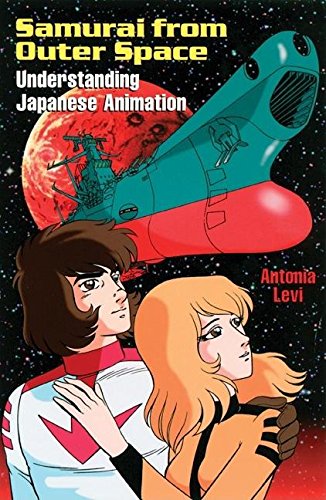Articoli correlati a Samurai from Outer Space: Understanding Japanese Animation

Sinossi
Compares Japanese anime to American cartoon animation, and demonstrates that many anime plots are based in Japanese religion
Le informazioni nella sezione "Riassunto" possono far riferimento a edizioni diverse di questo titolo.
Informazioni sull?autore
Antonia Levi has been a professor teaching Japanese history at Amherst College and Loyola Marymount University.
Le informazioni nella sezione "Su questo libro" possono far riferimento a edizioni diverse di questo titolo.
EUR 5,06 per la spedizione da U.S.A. a Italia
Destinazione, tempi e costiCompra nuovo
Visualizza questo articoloEUR 39,37 per la spedizione da U.S.A. a Italia
Destinazione, tempi e costiRisultati della ricerca per Samurai from Outer Space: Understanding Japanese Animation
Samurai from Outer Space: Understanding Japanese Animation
Da: ThriftBooks-Dallas, Dallas, TX, U.S.A.
Paperback. Condizione: Good. No Jacket. Pages can have notes/highlighting. Spine may show signs of wear. ~ ThriftBooks: Read More, Spend Less 0.77. Codice articolo G0812693329I3N00
Quantità: 1 disponibili
Samurai from Outer Space: Understanding Japanese Animation
Da: ThriftBooks-Dallas, Dallas, TX, U.S.A.
Paperback. Condizione: Very Good. No Jacket. May have limited writing in cover pages. Pages are unmarked. ~ ThriftBooks: Read More, Spend Less 0.77. Codice articolo G0812693329I4N00
Quantità: 1 disponibili
Samurai from Outer Space : Understanding Japanese Animation
Da: Better World Books Ltd, Dunfermline, Regno Unito
Condizione: Very Good. Ships from the UK. Former library book; may include library markings. Used book that is in excellent condition. May show signs of wear or have minor defects. Codice articolo 8638207-75
Quantità: 1 disponibili
Samurai from Outer Space: Understanding Japanese Animation
Da: Anybook.com, Lincoln, Regno Unito
Condizione: Fair. This is an ex-library book and may have the usual library/used-book markings inside.This book has soft covers. In fair condition, suitable as a study copy. Please note the Image in this listing is a stock photo and may not match the covers of the actual item,450grams, ISBN:9780812693324. Codice articolo 5960472
Quantità: 1 disponibili
Samurai from Outer Space: Understanding Japanese Animation
Da: WorldofBooks, Goring-By-Sea, WS, Regno Unito
Paperback. Condizione: Very Good. "Samurai from Outer Space" provides a discussion of the suddenly popular genre of Japanese animation. Japanese animation, also known as "anime" (pronounced Ah-nee-may), is gaining devoted fans of all ages and nationalities. A few years ago "anime" was something of an oddity. Now it is poised to become the biggest cultural import since PBS discovered the BBC. There are "anime" fan clubs on college campuses across the country, as well as "anime" fan magazines and "anime" sections in video stores. To enter the world of "anime" is to enter a world of fantasy in which all of the following have keen known to happen: a college student orders out for a pizza, gets a wrong number, and winds up with an immortal Norse deity for a roommate (in "Oh My Goddess!"); a black-haired boy named Ranma turns into a curvaceous redheaded female, whenever he gets splashed with cold water (in "Ranma 1/2", a series which also features a character named Dr Tofu); and a 21st century juvenile-delinquent biker, roaming the earth after World War III, gains apocalyptic powers and an overwhelming desire to blow up Tokyo (in "Akira"). The book contains insights that will help readers understand the many questions and often obscure conventions in "anime", for example: why does Japanese animation look so different from American animation?; why do the characters look Caucasian and have such huge, oversized, round eyes?; why did 50 Japanese animators send a letter to Walt Disney Studios concerning a controversy surrounding "The Lion King"; when a male character in "anime" suffers a nose bleed, why does this symbolise sexual arousal?; how are flashbacks signalled in Japanese animation?; and what do the science fiction "anime" featuring androids, cyborgs and other automatons reveal about the Confucian and Shinto views on organ transplants and genetic engineering? "Anime" is created by Japanese for Japanese. While subtitles and dubbing can help American viewers overcome the language barrier, to fully understand "anime" requires knowledge of Japan's prehistory, its Ninja myths and Samurai legends, its Buddhist and Shinto religions, artistic traditions such as woodblock printing, and philosophies such as Confuciansim. Antonia Levi looks at "anime" from two perspectives. First, she examines the roots of "anime" in Japan's history, mythology and culture. Second, she discusses why American audiences react as they do to an art form that was never intended for them. The Japanese views of truth, the universe, reason and reality are very different from American ones. The book has been read, but is in excellent condition. Pages are intact and not marred by notes or highlighting. The spine remains undamaged. Codice articolo GOR003626200
Quantità: 2 disponibili
Samurai from Outer Space : Understanding Japanese Animation
Da: Better World Books, Mishawaka, IN, U.S.A.
Condizione: Very Good. Used book that is in excellent condition. May show signs of wear or have minor defects. Codice articolo 4914274-6
Quantità: 1 disponibili
Samurai from Outer Space : Understanding Japanese Animation
Da: Better World Books, Mishawaka, IN, U.S.A.
Condizione: Good. Former library book; may include library markings. Used book that is in clean, average condition without any missing pages. Codice articolo 972755-6
Quantità: 1 disponibili
Samurai from Outer Space : Understanding Japanese Animation
Da: Better World Books, Mishawaka, IN, U.S.A.
Condizione: Good. Used book that is in clean, average condition without any missing pages. Codice articolo 6104331-6
Quantità: 1 disponibili
Samurai from Outer Space: Understanding Japanese Animation
Da: Wonder Book, Frederick, MD, U.S.A.
Condizione: Very Good. Very Good condition. A copy that may have a few cosmetic defects. May also contain a few markings such as an owner's name, short gifter's inscription or light stamp. Codice articolo B04B-02027
Quantità: 1 disponibili
Samurai from Outer Space Under
Da: SecondSale, Montgomery, IL, U.S.A.
Condizione: Very Good. Item in very good condition! Textbooks may not include supplemental items i.e. CDs, access codes etc. Codice articolo 00084596282
Quantità: 1 disponibili
